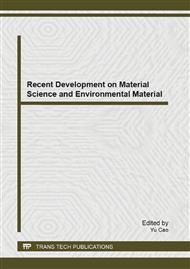p.555
p.560
p.565
p.569
p.573
p.576
p.580
p.584
p.593
Humic Acids Degradation and Membrane Fouling in Photocatalytic MF Systems for Drinking Water Treatment
Abstract:
Humic acids (HA) that are one of the major organic components in natural water play an important role in water treatment because they can interact with metals, trace organics, and chlorine while generating toxic complexes and by-products. In this work, photocatalytic degradation of HA and its kinetic behavior were investigated in a photocatalytic microfiltration (MF) system, along with evaluation of membrane permeability at different fluxes. The mechanisms of adsorption and desorption of HA on TiO2 surfaces were elucidated with adsorption isotherm tests of HA before and after photocatalysis of humic water. The kinetic parameters for humic acids, k (rate constant) and K (equilibrium adsorption coefficient) of the Langmuir-Hinshelwood equation, were obtained based on mass balances in continuous stirred tank reactor (CSTR) operations. Regarding membrane fouling, it was assumed that the rate of degree of fouling is disproportional to the fouling resistance. It was found that the fouling rate constant started increasing substantially when the flux increased to a level of greater than 50 L/m2-h. This indicated that the photocatalytic MF system should be operated at a flux below the critical value to prevent serious membrane fouling.
Info:
Periodical:
Pages:
573-575
Citation:
Online since:
September 2013
Authors:
Keywords:
Price:
Сopyright:
© 2013 Trans Tech Publications Ltd. All Rights Reserved
Share:
Citation:


